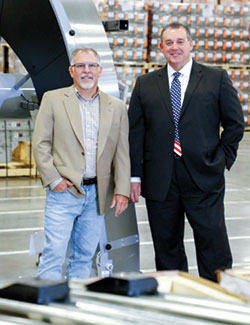 Some distribution centers are built with an expiration date in mind. Retailers, for instance, often think in terms of five years. Wine and spirits distributors are different: They often expect a DC to serve a region for as many as 20 years.
Some distribution centers are built with an expiration date in mind. Retailers, for instance, often think in terms of five years. Wine and spirits distributors are different: They often expect a DC to serve a region for as many as 20 years.
But over that time, the business evolves: Markets expand, the number of SKUs grows exponentially and customer service expectations change. And, in a market like greater New York City, the competition never sleeps.
Those are among the reasons that Southern Glazer’s Wine & Spirits, the largest distributor of wine and spirits in the country, took a phased approach to reinvigorate an old DC in Syosset, N.Y. The 475,000-square-foot DC serves New York City, Westchester County and the environs.
“To be in the New York City market, you need a large footprint, and you need an automated and scalable conveyor system,” says Roy Kohn, Southern Glazer’s vice president of operations for New York State. “We had reached the point that our volumes were exceeding our capabilities. We needed a bigger engine to drive volume out the door.”
That bigger engine wasn’t installed overnight. Instead, working with a systems integrator (Bastian Solutions), Southern Glazer’s launched a multi-phase approach to upgrading the facility, beginning in 2015.
- In Phase 1, the wine and spirits distributor upgraded an outdated conveyor and sortation system with new conveyor and a new warehouse execution and control system (WES and WCS) while retaining the existing sortation system. Southern Glazer’s also added spiral conveyors to optimize delivery of cases from a mezzanine-level accumulation area to the truck-loading area.
- Phase 2 saw the installation of a new bottle pick room—a two-level, voice-directed, split-case picking operation based on a design and best practices used by other Southern Glazer’s locations.
- Phase 3, which was recently completed, included a new warehouse management system (WMS), a case-handling shuttle system with capacity for 25,000 cases and a case dispensing system. The shuttle aggregates the storage of slow-moving and low-volume SKUs and returns while the case dispenser handles the fastest-moving SKUs.
The result, according to Kohn and Mark Booth, vice president of supply chain technology, is that bigger engine. “We’ve increased the life span of the building, which is more than 15 years old now; we’ve improved customer service; and we can meet customer service demands in a more efficient manner,” says Booth, who adds that the facility is currently shipping out almost 10 million cases a year.
Read the full article from Modern Materials Handling